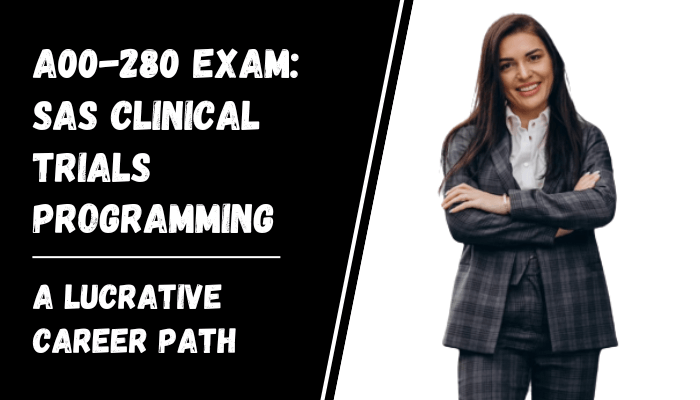Introduction
The SAS Clinical Trials Programming exam is a certification program that evaluates the skills and knowledge of professionals in the field of clinical trial programming using the SAS software. It is designed to test the ability of individuals to manipulate and analyze clinical trial data while adhering to regulatory standards. This article will provide an overview of the exam format, syllabus topics, career opportunities, and study tips for those preparing to take the exam.
What is SAS Clinical Trials Programming?
SAS Certified Clinical Trials Programming Using SAS 9 refers to the use of SAS software to manage, analyze, and report clinical trial data. SAS Clinical Trials Programmers are responsible for developing and validating SAS programs used in clinical research, creating tables, listings, and figures (TLFs), and generating reports. SAS is considered the gold standard in clinical data analysis and is widely used in the pharmaceutical industry.
Learning Clinical Trials Programming has several benefits. It provides individuals with the skills and knowledge required to develop and manage clinical trial data effectively. It also enables them to work with the latest technologies and tools used in the industry, thereby enhancing their career prospects.
Knowing the Test Setup
The SAS Certified Clinical Trials Programming exam is a globally recognized certification for SAS Clinical Trials Programmers. The exam duration is 180 minutes, and it consists of 95-100 multiple-choice questions. The registration process is straightforward, and candidates can register for the exam online on the SAS website.
To pass the exam, candidates need to score a minimum of 70%. The exam tests the candidate’s knowledge of SAS programming, clinical trial data, and statistical procedures.
Overview of the SAS A00-280 Exam Topics
The SAS Certified Clinical Trials Programming (A00-280) exam covers several topics related to clinical trial data analysis using SAS software. The syllabus includes Clinical Trials Process, Import and Export Clinical Trials Data, Clinical Trials Data Structures, Manage Clinical Trials Data, Transform Clinical Trials Data, Apply Statistical Procedures for Clinical Trials, Macro Programming for Clinical Trials, Report Clinical Trials Results, and Validate Clinical Trial Data Reporting.
Each topic covered in the syllabus is of great importance in the pharmaceutical industry. Data access, management, and transformation are essential for managing and analyzing clinical trial data. Data presentation and reporting enable programmers to generate TLFs and reports. Statistical procedures and macro programming provide programmers with the skills required to perform complex data analysis. Validation of clinical trial data reporting ensures the accuracy and consistency of the data generated.
SAS Clinical Trials Programming Eligibility
Depending on your level of experience, you may not require all preparation components. For example, a SAS Certified Base Programmer would not require the Programming 1 and 2 classes. Review the exam objectives and then determine which materials will complete your preparation.
Roles and Responsibilities for SAS Clinical Trials Programmer
SAS Clinical Trials Programmers play a crucial role in the pharmaceutical industry. Their responsibilities include developing and validating SAS programs, creating and maintaining data sets, generating reports and graphics, and ensuring that all data meets regulatory requirements. These professionals also collaborate with cross-functional teams, including statisticians, data managers, and medical writers, to ensure the accuracy and integrity of clinical trial data.
To excel in this role, Clinical Trials Programmers must have a strong understanding of SAS programming languages and clinical trial processes. They must also possess excellent problem-solving skills, attention to detail, and the ability to work well under pressure.
The field of SAS Clinical Trials Programming offers many career growth opportunities, including roles in project management, data analysis, and clinical trial design.
Preparation Strategies for the SAS Clinical Trials Programming Exam
If you’re preparing for the SAS Clinical Trials Programming exam, you need to be well-prepared to pass it with flying colors. In this section, we’ll share some tips and tricks that can help you prepare for the exam and ace it.
- Familiarize Yourself with the Exam Format: It’s important to know the exam format so you can plan your preparation accordingly. The SAS Clinical Trials Programming exam is a multiple-choice exam, and you’ll have three hours to complete it. You can register for the exam online, and the cost of the exam is $180.
- Refer to the Official SAS Learning Path: SAS provides a Learning Path for the SAS Certified Clinical Trials Programming Using SAS 9 exam, which is an excellent resource for exam preparation. The Learning Path includes a study guide, practice questions, and video tutorials to help you prepare for the exam.
- Practice with Sample Questions: Practicing with sample questions can help you get a feel for the types of questions you’ll encounter on the exam. SAS provides sample questions on its website, and you can also find practice questions in study guides and online resources.
- Take Advantage of SAS Training Courses: SAS offers training courses for SAS Clinical Trials Programming, which can be very helpful in preparing for the exam. These courses cover the exam topics in-depth and provide hands-on experience working with SAS software.
- Focus on the Exam Topics: It’s important to focus your study efforts on the exam topics, so you can be well-prepared for the questions that will be asked. The SAS Clinical Trials Programming exam covers a variety of topics, including clinical trial data structures, programming techniques, and reporting.
- Manage Your Time Effectively: Time management is critical when taking the SAS Clinical Trials Programming exam. Make sure you have a good understanding of the exam format, so you can plan your time accordingly. It’s also important to pace yourself during the exam to ensure you have enough time to answer all the questions.
- Take Breaks and Stay Relaxed: Taking regular breaks can help you stay focused and relaxed during the exam. Make sure you take short breaks to stretch, get some fresh air, or grab a snack. It’s also important to stay calm and focused during the exam, so you can perform your best.
By following these tips and tricks, you can be well-prepared for the SAS Certified Clinical Trials Programming exam and increase your chances of passing with flying colors.
Conclusion
In conclusion, Clinical Trials Programming Using SAS 9 plays a critical role in the pharmaceutical industry by ensuring the accuracy and integrity of clinical trial data. The field offers many career growth opportunities and competitive salaries for those with the necessary skills and qualifications. To excel in this field, it is essential to have a strong understanding of SAS programming languages, clinical trial processes, and the ability to work collaboratively with cross-functional teams. By following the study tips and tricks outlined in this article, you can increase your chances of success on the SAS Certified Clinical Trials Programming exam and kick-start your career in this exciting field.







